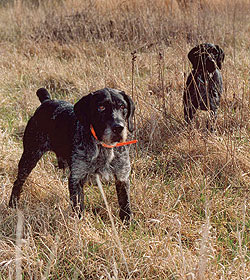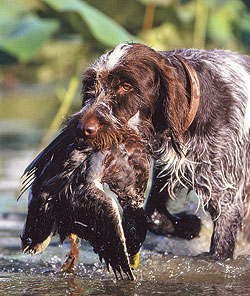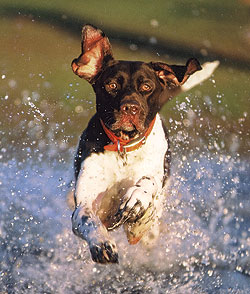The NAVHDA Invitational might change your thinking!
By Bob West
 Two Versatile Champions, Ken the German wirehair (foreground) and Nick the German shorthair, actually titled in different years but this picture shows a nice piece of work--pointing and backing--as would be expected in the event. |
I don't know how many times I've heard hunters say they don't want to buy a pup or dog from hunt test or field trial stock, somehow reasoning they would be "too hot," "high strung" or "independent" to make a good hunting dog.
Well, folks, to the contrary, the very premises of hunt tests and trials are to evaluate the breeding worth of individuals, ideally ruling out those self-serving crazies with poor work ethics in favor of solid, hard working yet biddable individuals with a good nose, mental stability, correct conformation and other inheritable characteristics as a measure of value for future breeding programs.
So don't blame the contest; those of us who participate in them don't want those nutcases, either. As an example, let's discuss what's expected of dogs hoping to qualify in the programs sponsored by the North American Versatile Hunting Dog Association (NAVHDA). I'm sure you'll agree those attributes and abilities are precisely what are needed in the field or marsh€¦in fact, that's exactly where you'll find these same dogs in the fall.
The more we understand hunt tests and field trials the better we understand how they are designed as proving grounds for discriminating breeders to select the very best for potential litters. While showcasing NAVHDA's system and wrapping up by featuring our International Versatile Championship, I hope to whet your interest enough to consider testing your own dog(s) in those programs. Like all dog clubs, NAVHDA welcomes visitors and test days offer you a chance to meet others with common interests, even join the group and benefit in help with your dog's training.
To better appreciate the Versatile Champion, NAVHDA's top achievement, we should know the road they've traveled to even qualify to enter the test.
Many of you know NAVHDA is dedicated to fostering and promoting the versatile hunting dog through its extensive testing program, much like the AKC hunt tests for retrievers, pointing dogs and spaniels and the UKC's Hunting Retriever program.
NAVHDA is a testing program, not a field trial.
In testing, all dogs are evaluated by trained judges against predetermined standards, rather than competing with each other as in a field trial.
NAVHDA's program begins with Natural Ability tests, where dogs eight or nine months up to 16 months old are evaluated for those inherited characteristics needed to become great hunting dogs. Typical NA tests will involve a bird field, where pups are to search out and point game birds. Steadiness is not required, nor is retrieving.
They are then asked to track a running pheasant, followed by a water segment where they are to swim two times after a training dummy. Seemingly simple, although the test allows trained judges to evaluate each pup's "natural abilities" or inherited characteristics for an individual score, and in turn gives breeders some measure of their program.
Upping the Ante
The next level is the Utility Preparatory test, where training and obedience play a bigger roll yet inherited quality continues to weigh heavily. In UPT field tests dogs are asked to search out and point game then remain steady until the shot is fired, plus retrieve the downed bird.
 Fetching waterfowl is one of the many tasks expected of a versatile hunting dog. |
UPT dogs are asked to complete a drag of around 60 yards, where a dead gamebird is dragged by one of the judges to a place out of sight and the dog then follows the scent trail to locate and return with the bird.
The UPT water portion involves two parts. First, the dog remains steady by a blind while a duck is thrown and a shotgun blank is fired, then asked to complete the 40-yard marked water retrieve. In the next water segment, our UPT dog is required to be steady while a shotgun blank is fired, then is sent to search a marsh area for a downed duck.
Although by NAVHDA standards a UPT dog is only halfway to the Utility Level's standards, most hunters would be very proud to own one.
Utility tests come next and these are where dogs can actually qualify for a chance to run in an International Test and the opportunity to earn the title of Versatile Champion.
Utility tests are quite involved and PPin keeping with the idea of an all-around or versatile dog, including upland, water and tracking segments as the NA and UPT, but with more complex hunting scenarios and demanding obedience requirements.
A Utility dog's field search has to be strong and show purpose in a tireless effort to locate and point birds for the gun. Once pointed the dog has to stand steady through the flush, shot, and fall of the bird, then on command retrieve promptly and gently to hand.
At some time during the day's test each dog will be required to complete a drag. While dog and handler are in a holding blind, one of the judges will drag a dead gamebird through the grass and brush 100-plus yards, to a point out of sight of dog and handler.
The dog is then asked to follow the scent trail and retrieve to hand.
In the UT water segments, the dog is first heeled several yards through natural cover and positioned off lead near a duck blind. The handler moves out of sight and fires two blank shotgun loads to simulate ducks being shot on the marsh, then returns to his dog, who is required to remain steady at the blind as commanded.
Still at the blind, our hunting team now readies for a 60-yard marked duck retrieve over decoys, further complicated by three diversion shotgun blanks being fired. Once the dog and handler are ready the diversion shots will simulate other hunting activity nearby, thus testing the dog's steadiness and concentration on the job at hand. Following diversions, a duck is thrown as our handler fires another blank at the duck. On command, our dog then swims through decoys and retrieves to hand.
As if that's not enough, during another water segment the UT dog is asked to s
earch a large marsh for a downed duck. For this test, a shackled duck is thrown far out in the marsh while our dog handler team is in a holding blind. Later, after the duck has swum out of sight, the dog is heeled to some point near the bank, another blank is fired, and on command the dog is asked to show a good strong searching effort to locate and retrieve the duck it hasn't seen.
 Willingness to enter and retrieve from water is an inherited trait evaluated in NAVHDA tests. |
Here's the kicker. In all NAVHDA tests, dogs have to complete all phases successfully during that day's testing to qualify. Those qualifying will receive a classification of Prize 1, 2, or 3 based on their qualities and level of training, with Prize 1 being the highest.
Only Prize 1 UT dogs are eligible to enter an Invitational Test.
Championship skills
Okay, now that we know what it takes to get in the door, let's go over what's expected of a dog to earn the Versatile Champion (VC) title.
During the upland field portion of the Invitational test, dogs are braced for an hour on an upland hunting course and expected to show a strong forward and productive search throughout, aware of and cooperating with each other and their handlers.
When birds are located, dogs should point well off and stand intently. They must be steady to wing, shot and fall, then on command quickly retrieve to hand.
Backing a bracemate's point is also mandatory and once backed, a dog has to stand steady during the shot, fall, and retrieve of its bracemate's bird.
Another wrinkle--stop-to-flush birds are shot when it is safe to do so, and again the dog is expected to remain steady until sent. During pointing, backing and stop-to-flush sequences, dogs are expected to be steady without command in all sequences.
At the water, we have three primary segments.
The first involves a typical duck hunting scenario where two decoying ducks are shot while the dog remains steady. The first falls in open water around 50 yards to the front, then a crossing duck is shot, landing closer and to the side. While the dog is retrieving this last duck a diversion shot is fired; the dog is expected to disregard the diversion and retrieve to hand. In addition, the dog must remember and retrieve the first duck when sent.
Our second water segment is a 100-yard blind retrieve. Before the test begins a dead duck is thrown to the water's edge on an opposite bank, approximately 100 yards across open water from the starting line. The duck is then dragged several yards up the bank into cover simulating how a cripple might have crawled up the bank a ways before expiring.
Remember, the test dog has not seen any of the set-up before being brought to the line. Once at the line the handler sends his dog for the retrieve.
Obviously the blind is a handling test, where the dog is expected to show initiative yet willingly accept direction from its handler to cross the water to the area of the duck, then locate and retrieve it to hand.
The third part involves an honor during a short retrieve by a "bye" dog. In this sequence, our test dog is positioned near the water near a bye dog and is expected to remain steady and quiet while shots are fired and the bye dog retrieves a duck falling only a few yards to the front.
Only those dogs successfully completing all phases of testing in the top percentile achieve NAVHDA's Versatile Champion Title.
Wouldn't choosing a pup from such breeding make sense?
This year's NAVHDA International Invitational will be held near Lynnville, Iowa, beginning the 23rd of September and continuing through that weekend. Please come out and join us!
If you can't make it to the Invitational, check out NAVHDA's website for info on events nearby: www.navhda.org.






